异步消息处理机制相关面试问题-handlerThread面试问题详解
handlerThread产生背景:
开启Thread子线程进行耗时操作,多次创建和销毁线程是很耗系统资源的。
handlerThread是什么?
handler + thread + looper
它其实也是一个线程,只是跟Thread是有区别的,它是一个thread内部有looper,
handlerThread的特点:
- 它本质上是一个线程,它继承了Thread。
- 它有自己的内部Looper对象,可以进行looper循环。
- 通过获取HandlerThread的looper对象传递给Handler对象,可以在handleMessage方法中执行异步任务。
- 优点是不会阻塞,减少了对性能的损耗,缺点是不能同时进行多任务的处理,需要等待进行处理,处理效率较低。
- 与线程池注重并发不同,HandlerThread是一个串行队列【也就是任务必须一个个执行,只有一个执行完了才会执行下一个】,HandlerThread背后只有一个线程。
handlerThread源码解析:
先贴一下它的完整源码:
/**
* Handy class for starting a new thread that has a looper. The looper can then be
* used to create handler classes. Note that start() must still be called.
*/
public class HandlerThread extends Thread {
int mPriority;
int mTid = -1;
Looper mLooper; public HandlerThread(String name) {
super(name);
mPriority = Process.THREAD_PRIORITY_DEFAULT;
} /**
* Constructs a HandlerThread.
* @param name
* @param priority The priority to run the thread at. The value supplied must be from
* {@link android.os.Process} and not from java.lang.Thread.
*/
public HandlerThread(String name, int priority) {
super(name);
mPriority = priority;
} /**
* Call back method that can be explicitly overridden if needed to execute some
* setup before Looper loops.
*/
protected void onLooperPrepared() {
} @Override
public void run() {
mTid = Process.myTid();
Looper.prepare();
synchronized (this) {
mLooper = Looper.myLooper();
notifyAll();
}
Process.setThreadPriority(mPriority);
onLooperPrepared();
Looper.loop();
mTid = -1;
} /**
* This method returns the Looper associated with this thread. If this thread not been started
* or for any reason is isAlive() returns false, this method will return null. If this thread
* has been started, this method will block until the looper has been initialized.
* @return The looper.
*/
public Looper getLooper() {
if (!isAlive()) {
return null;
} // If the thread has been started, wait until the looper has been created.
synchronized (this) {
while (isAlive() && mLooper == null) {
try {
wait();
} catch (InterruptedException e) {
}
}
}
return mLooper;
} /**
* Quits the handler thread's looper.
* <p>
* Causes the handler thread's looper to terminate without processing any
* more messages in the message queue.
* </p><p>
* Any attempt to post messages to the queue after the looper is asked to quit will fail.
* For example, the {@link Handler#sendMessage(Message)} method will return false.
* </p><p class="note">
* Using this method may be unsafe because some messages may not be delivered
* before the looper terminates. Consider using {@link #quitSafely} instead to ensure
* that all pending work is completed in an orderly manner.
* </p>
*
* @return True if the looper looper has been asked to quit or false if the
* thread had not yet started running.
*
* @see #quitSafely
*/
public boolean quit() {
Looper looper = getLooper();
if (looper != null) {
looper.quit();
return true;
}
return false;
} /**
* Quits the handler thread's looper safely.
* <p>
* Causes the handler thread's looper to terminate as soon as all remaining messages
* in the message queue that are already due to be delivered have been handled.
* Pending delayed messages with due times in the future will not be delivered.
* </p><p>
* Any attempt to post messages to the queue after the looper is asked to quit will fail.
* For example, the {@link Handler#sendMessage(Message)} method will return false.
* </p><p>
* If the thread has not been started or has finished (that is if
* {@link #getLooper} returns null), then false is returned.
* Otherwise the looper is asked to quit and true is returned.
* </p>
*
* @return True if the looper looper has been asked to quit or false if the
* thread had not yet started running.
*/
public boolean quitSafely() {
Looper looper = getLooper();
if (looper != null) {
looper.quitSafely();
return true;
}
return false;
} /**
* Returns the identifier of this thread. See Process.myTid().
*/
public int getThreadId() {
return mTid;
}
}
以上就是它的完整源码,挺少的,但是设计很精妙,先来看一下它的类注解:

其中它就是继承Thread,很明显就是一个线程,接着来往下分析:
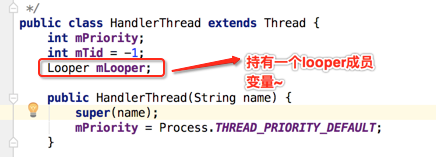

通过下面这句代码就可以知道:
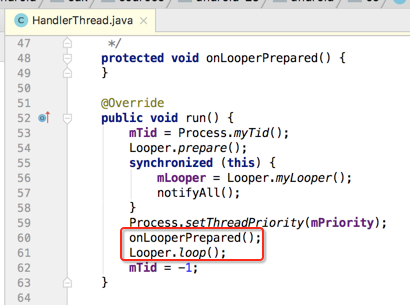
接着看一下线程最核心的run()方法:
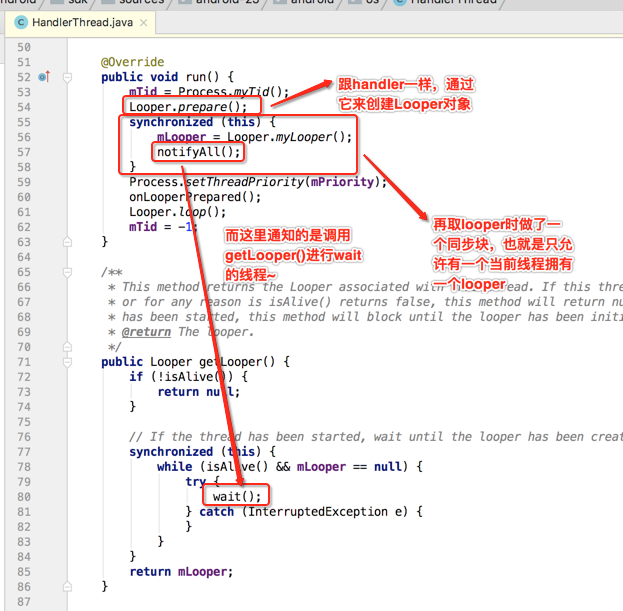
最后执行loop方法:
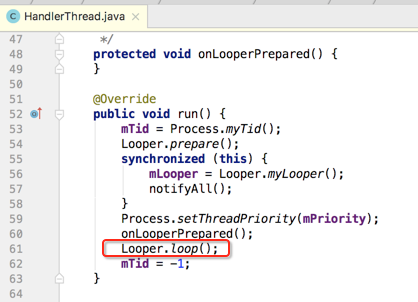
而看一下getLooper()方法:
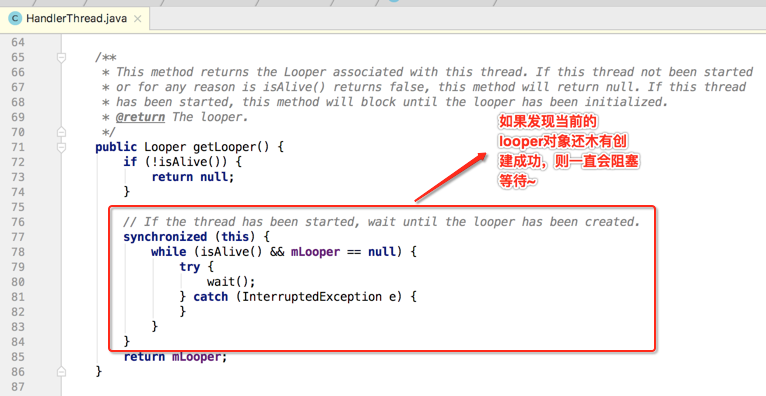
最后再看一下跟退出相关的方法:
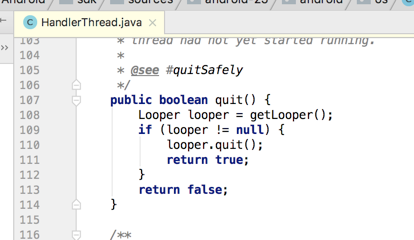
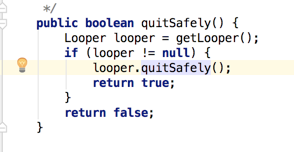
其中安全的退出效率肯定没有直接退出效率高。
异步消息处理机制相关面试问题-handlerThread面试问题详解的更多相关文章
- 异步消息处理机制相关面试问题-intentservice面试问题详解
IntentService是什么? IntentService是继承并处理异步请求的一个类,在IntentService内有一个工作线程来处理耗时操作,启动IntentService方法和启动传统的S ...
- 异步消息处理机制相关面试问题-handler面试问题详解
什么是handler? 这个异常应该也就是引出handler的原因,也就是默认在非UI线程中是无法去更新UI的东东滴,那到底什么上handler呢? handler通过发送和处理Message和Run ...
- 异步消息处理机制相关面试问题-AsyncTask面试问题详解
什么是AsyncTask: 它本质上是一个封装了线程池和handler的异步框架. AsyncTask的使用方法: 三个参数: 五个方法: AsyncTask的内部原理: AsyncTask的注意事项 ...
- 【转】Android 异步消息处理机制 让你深入理解 Looper、Handler、Message三者关系
转载请标明出处:http://blog.csdn.net/lmj623565791/article/details/38377229 ,本文出自[张鸿洋的博客] 很多人面试肯定都被问到过,请问Andr ...
- Android 异步消息处理机制 让你在深入了解 Looper、Handler、Message之间的关系
转载请注明出处:http://blog.csdn.net/lmj623565791/article/details/38377229 ,本文出自[张鸿洋的博客] 非常多人面试肯定都被问到过,请问And ...
- Android 异步消息处理机制 让你深入理解 Looper、Handler、Message三者关系
转自:http://blog.csdn.net/lmj623565791/article/details/38377229 ,本文出自[张鸿洋的博客] 很多人面试肯定都被问到过,请问Android中的 ...
- 【转载】Android异步消息处理机制详解及源码分析
PS一句:最终还是选择CSDN来整理发表这几年的知识点,该文章平行迁移到CSDN.因为CSDN也支持MarkDown语法了,牛逼啊! [工匠若水 http://blog.csdn.net/yanbob ...
- Android 异步消息处理机制终结篇 :深入理解 Looper、Handler、Message、MessageQueue四者关系
版权声明:本文出自汪磊的博客,转载请务必注明出处. 一.概述 我们知道更新UI操作我们需要在UI线程中操作,如果在子线程中更新UI会发生异常可能导致崩溃,但是在UI线程中进行耗时操作又会导致ANR,这 ...
- Android多线程----异步消息处理机制之Handler详解
[声明] 欢迎转载,但请保留文章原始出处→_→ 生命壹号:http://www.cnblogs.com/smyhvae/ 文章来源:http://www.cnblogs.com/smyhvae/p/ ...
随机推荐
- Python3 Selenium自动化web测试 ==> 第八节 WebDriver高级应用 -- 结束Windows中浏览器的进程
学习目的: 掌握WebDriver的高级应用 正式步骤: # -*- coding:utf-8 -*- from selenium import webdriver from selenium.web ...
- 禁止crontab -r清空定时任务列表误操作
关于crontab 1.附件cron.sh放/usr/bin目录下面 2.在/etc/bashrc文件末尾添加 alias crontab='/usr/bin/cron.sh' 或者在当前root用户 ...
- AFNetworking网址中有中文崩溃的问题
AFHTTPRequestOperationManager *manager = [AFHTTPRequestOperationManager manager]; manager.responseSe ...
- Centos7搭建主从DNS服务器
1.准备 例:两台192.168.11.10(主),192.168.11.11(从),域名www.test1.com # 主从DNS服务器均需要安装bind.bind-chroot.bind-util ...
- mysql数据库设置密码
1.用SET PASSWORD命令 mysql -u root mysql> SET PASSWORD FOR 'root'@'localhost' = PASSWORD('newpass'); ...
- 深入理解C语言-二级指针三种内存模型
二级指针相对于一级指针,显得更难,难在于指针和数组的混合,定义不同类型的二级指针,在使用的时候有着很大的区别 第一种内存模型char *arr[] 若有如下定义 char *arr[] = {&quo ...
- Linux系列之putty远程登录
在工作中,我们通常都是通过远程操作Linux服务器的,因此必须熟悉一些远程登录的软件,在此使用的是putty,在Windows上安装putty软件,通过该软件访问Linux主机. 1.远程登录步骤 1 ...
- CVPR2019目标检测方法进展综述
CVPR2019目标检测方法进展综述 置顶 2019年03月20日 14:14:04 SIGAI_csdn 阅读数 5869更多 分类专栏: 机器学习 人工智能 AI SIGAI 版权声明:本文为 ...
- 命名规范 camel case, pascal case, hyphen
2019-11-08 refer : https://ux.stackexchange.com/questions/43174/update-vs-modify-vs-change-create-v ...
- JSON函数表1
jsoncpp 主要包含三个class:Value.Reader.Writer.注意Json::Value 只能处理 ANSI 类型的字符串,如果 C++ 程序是用 Unicode 编码的,最好加一个 ...
